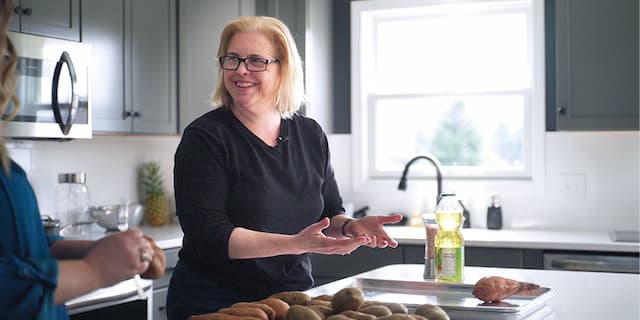Every Sermon Is Incomplete

For the season of Lent at Carlton Landing Community Church, we’re reading together through the Gospel of John. Our goal is to add a time to read, pray, and share each day as we prepare our hearts for Easter.
One of the joys for me has been doing the reading and writing short devotionals to accompany the Scripture each day. For the six Sundays between now and Easter, I’m preaching on the “I Am” statements in John, and so the readings during the week build up to and expand on the texts I’m preaching. Having these bite-sized devos ready during the week relieves one of the tensions of preaching this way – hitting significant portions of John but not going verse by verse – because it provides some of the context that won’t make it into the sermon.
Every preacher struggles with the question, “how much do I keep in and how much do I leave out?” I prepare the sermon by reading and translating the text, studying the words, phrases, connections, and cross-references, formulating a broad reading, writing down some unanswered questions, and then turning to commentaries and other resources to further understand what the text is saying. The only problem in doing things this way is that you end up with a ton of material. Leave in too much, and your sermon turns into a commentary. Leave in too little, and there’s nothing to sink your teeth into.
Of course, the goal of a sermon, as opposed to certain other kinds of lessons, is not just to explain the text but to proclaim it. I’ve heard one pastor say the transition from preparation to preaching is going from the third person to the second person. Only some of the material and specific lines of argument or explanation serve the goal of proclamation. Everything else must be jettisoned to the cutting room floor.
The other angle of preaching a textual series without going through the whole book, verse by verse, is figuring out where to put critical pieces of context in the sermon series. As an example, I started the series in John 6 with the bread of life discourse. But how can you talk about the bread of life when you haven’t covered the prologue? Or the feeding of the 5,000 right before?
In the next sermon, “I am the light of the world” in 8:12-20, another interesting wrinkle comes into play. It’s impossible to understand that passage without reading Jesus’ initial conversation about witnessing in 5:19-47. Once you read that passage, you understand that covering the purpose of the signs throughout the gospel is another essential thread in pulling the whole book together. It all makes me thankful for the ability to point our congregation to the reading plan during the week.
That said, here’s the reminder; every sermon is incomplete. No matter what or how you preach, what tools you deploy, or how much material you provide, preaching is always an exercise in incompleteness. You’ll never be able to exhaust the text, cover the context, or apply all God has for the people listening. What wonderful news that is.
Don’t mistake incompleteness for futility. Here’s the difference. God will use your incomplete sermon to bring fruit and growth from his Word. And then he’ll use someone else’s on the same text to apply a different point. Then he’ll bring the text to mind in a specific circumstance and teach a new lesson all over again.
Texts have one meaning but an infinite number of applications. If you’re teaching or preaching, you have to get the meaning of the text and apply it – incompletely – to the people you have before you. The Scriptures are inexhaustible, so give it everything you have and know that the next time you read that very same text God will have something new for you to learn.
On the other side of the pulpit, when you’re listening, every sermon is better when you’re reading the Bible during the week. One way to maximize the impact of every sermon is to come ready, having read the Bible during the week. Then you’ll bring much of the context with you. Your heart is pre-conditioned; God’s already been working on you and preparing you for what you’re about to hear. Reading during the week, especially the same text or the same book, is like stretching before a sprint. When you get there, you’re ready to listen. The Bible will come alive when what you’ve been reading connects with what your pastor has been preparing during the week.
A week in, I’m already thankful for the reminder that I will never preach a “complete” sermon. Formation happens throughout the week. Sunday is just a lit match. When we read during the week, we’re connecting with God and growing in our relationship with him. We’re also gathering kindling.
Here’s an excerpt from the post scheduled for tomorrow on Jesus and Nicodemus, John 3:1-21.
You’re probably familiar with the story of Nicodemus, “Nick at Night” as one pastor I know refers to it. A member of the Jewish religious elite – the Pharisees – comes to talk with Jesus under the cover of darkness. When Jesus tells him he must be born again he wonders what that could possibly mean. We don’t get to hear the end of this conversation. Does he believe what Jesus says? Is he born again?
The choice Jesus presents Nicodemus is one we all have to make. Do you want to be born again? Not by reinventing your image or making a few positive changes, do you want to be born again by the Spirit of God? When you step back, Nicodemus’ confusion is easy to understand. Is it really possible that your life could start over in the middle? Can you really become a new person? Could God give you eternal life just for trusting in his Son? That’s exactly what Jesus promises.
Both Jesus and Nicodemus probably had Ezekiel 36:22-32 in mind as they were talking. There, God says, “And I will give you a new heart, and a new spirit I will put within you. And I will remove the heart of stone from your flesh and give you a heart of flesh. And I will put my Spirit within you, and cause you to walk in my statutes and be careful to obey my rules. You shall dwell in the land that I gave to your fathers, and you shall be my people, and I will be your God.”
You may not remember how the story of Nicodemus ends. Later in the gospel, we see Nicodemus again. In John 7, Nicodemus speaks up for Jesus during a meeting of the Pharisees. Something is changing in Nicodemus. In John 19:39, the transformation is complete. Joseph of Arimathea came to take the body of Jesus and put it in his tomb. And John adds, “Nicodemus also, who earlier had come to Jesus by night, came bringing a mixture of myrrh and aloes.” He wasn’t coming by night anymore. Now, he was all in.
There are a lot of “Nicodemus stories.” It’s not always a spur-of-the-moment conversion. Nicodemus came first with questions. Then he started to see Jesus’ perspective. Then he started to wonder if he might be right. Then he decided to follow him. Over time, Nicodemus was born again.
Cole Feix is the founder and president of So We Speak and the Senior Pastor of Carlton Landing Community Church in Oklahoma.




